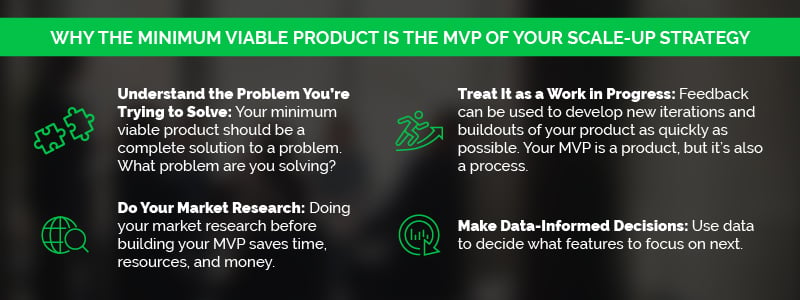Why the Minimum Viable Product Is the MVP of Your Scale-up Strategy

Your minimum viable product allows you to get your introductory product or offer to market quickly, without overbuilding or overspending. Here’s why it should be the star of your scale-up strategy.

If building a successful business was as simple as having a good idea, everyone would have a successful business. Having a good idea isn’t enough. Your idea needs to be viable — that is, it needs to work, there needs to be a market for it, and it needs to be profitable. Building out your minimum viable product (MVP) is an ideal way for your business to prove your viability and develop a baseline product that you can make the rising star of your scale-up strategy.
Eric Ries, the author of The Lean Startup and creator of the Lean Startup methodology, defines the minimum viable product as “that version of a new product which allows a team to collect the maximum amount of validated learning about customers with the least effort.”
A minimum viable product is the simplest, most bare-bones version of your product or service that is built well enough to justify engagement and early-adopter customers, but it isn’t overbuilt so you waste time or money if there turns out to be no market. Feedback will be used to develop new iterations and versions of the product as quickly as possible, allowing you to get your MVP to market as quickly as possible while still being able to improve on it as a work in progress.
Some of the most famous and successful companies in the world today — household names — started out as meager minimum viable products that were scaled to billion-dollar companies. Dropbox, Groupon, Amazon, Spotify, Twitter, and Airbnb all started out as MVPs before they became billion-dollar brands.
Understand the problem you’re trying to solve
All businesses exist as solutions to problems — so do all products and services. What problem is your minimum viable product solving for your customers? Identifying the problem helps not only identify solutions but also ensures that the solutions you develop are complete. Remember, you want to develop a minimum viable product, not a half-baked, incomplete product that looks like it went to market too soon.
Understanding the problem that you’re trying to solve helps you realize when you’ve hit the right solution and how to test it, test it again, and test it some more — which you’ll need to do throughout the process of developing various iterations of your minimum viable product.
Remember that, while the immediate goal is always to launch and get in front of your customers as quickly as possible, the real goal is to be of service and provide your customers with solutions to their most pressing problems.
Do your market research
The number one reason startups fail is due to misreading market demand — this is true in almost half of cases. Doing market research before building an MVP is a wise use of resources and can help ensure you don’t waste time or money on something there’s no market for. Get out there and talk to your customers. Dropbox, for example, used a simple landing page that explained what their service would be to gauge interest before they ever launched the actual service.
You can also use an MVP for market research by testing a particular product with live customers before committing a substantial portion of the budget to full product development.
Amazon started as a humble list of 20 things that could be marketed online. Jeff Bezos, Amazon’s founder, narrowed the list down to five things. After market research, he decided on books because of the low price, variety of titles, and high demand across the world. He put it online and ran it out of his garage as his minimum viable product.
Treat it as a work in progress
Once he had his minimum viable product — the bare minimum needed to get in front of customers and start selling — Bezos continued to make improvements and innovate. This took Amazon through various iterations until it became the billion-dollar company we know today. It’s now the third-largest retailer in the world. How’s that for scaling a business?!
Treating your minimum viable product as a work in progress allows you to utilize customer feedback to make continued improvements and enhancements to it, introducing new features, developing new iterations, and even utilizing your MVP as a baseline framework to build new products and offers. Your minimum viable product is a product, yes — but it’s also a process.
Make data-informed decisions
Unfortunately, not every startup will have an Amazon-style success story. Overbuilding and overspending is a huge problem for startups. It’s well-known that 90% of startups fail, but did you know that the second-most common reason they fail is overspending and running out of money?
Have you heard the saying “The customer is always right”? So is the data. Take an in-depth look at your data to find common questions or problems from customers that could be resolved with the addition of a feature or new offerings. Look for common feature requests and identify commonly used functions.
Any new feature or product you release needs to solve a problem for your customer, and it needs to be tested. Data gives you an idea of what features to focus on and which direction to go next as you develop the next iteration of your MVP.
Let the experts at MetaGrowth help you max out your MVP
At MetaGrowth, we deliver massive growth with minimal investment, so you can ditch the daily grind of “founder selling” and have an amazing team of dedicated sales professionals to do your selling for you. Co-founders Josh Hirsch and Joe Arioto will put their combined 30,000 hours of coaching and consulting expertise to work for you on solutions-based sales consulting that will help you free up time to focus on what really matters: Your growth strategy.
If you want to build your very own world-class sales team without investing a ton of time — not to mention headaches or hassles — contact us today. We’ll help you build a dream team to start boosting your sales in no time!
Written by
Joe Arioto
